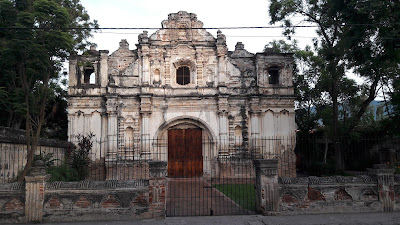Earlier this month, I had the opportunity to visit the city of
Antigua, in
Guatemala, for just a couple of days. This is going to be a quite short report, since I barely had time to bird... I spend most of my time attending an academic activity. Antigua, with its cobbled streets, colonial buildings and warm people is an
UNESCO World Heritage Site, and its convoluted history is quite interesting.
 |
| Typical cobbled street in Antigua |
 |
| Agua Volcano in the background |
I have to admit that I was more interested in the natural marvels surrounding this beautiful city... not only birds, but also a landmark we are not used to see in Panama: volcanoes. My wife warned me about the active volcanoes surrounding the city... she climbed the smoky Pacaya Volcano during her visit to the country some years ago (check
this post)... but I was not prepared for the sighting of an active volcano spewing fire, lava and clouds of ash!
 |
| Fuego Volcano |
I took the above photo around the corner of my hotel! That's the Fuego Volcano in a way I never dreamed to see... scary (at least for this Panamanian)! I tried to sleep that night trying not to think on that sight of course; instead, I thought of the new birds I was about to see, since it was my first time in northern Central America and was pretty sure that even the common birds would be lifers. The very first bird I saw was a Great-tailed Grackle (the most common one in Panama City!)... but then I got some nice lifers right at the main plaza, like Pacific Parakeet, Inca Dove, Golden-fronted Woodpecker, Black-capped Swallows and Yellow-winged Tanagers. However, my favorite lifer at the city was the Bushy-crested Jay that I found in a wooded area very close to the hotel.
 |
| Bushy-crested Jay, adult |
 |
| Bushy-crested Jay, immature |
This species is restricted to northern Central America, and was conspicuous and noisy (well, is a jay after all). It was my last life bird in the city, and I knew that I had to get out of the city into the woods if I wanted more life birds. After a quick internet search it was clear that the place to go was Finca El Pilar, just 10 minutes away of the main plaza. Taking advantage of the only free afternoon, I took some hours to bird the trails. At first the activity was low... but this sign kept me optimistic!
The hummingbird feeders attracted both Violet and Cinnamon Sabrewings, Magnificent, Azure-crowned and White-eared Hummingbirds, and Green-throated Mountain-Gems (four of them life hummers for me), while White-naped Brush-Finches, Band-backed Wrens and more Bushy-crested Jays roamed the forest interior.
 |
| Cinnamon Sabrewing |
 |
| White-naped (Yellow-throated) Brush-Finch |
I had the trails for my own, so I was able to see some secretive forest-dwellers like Ruddy Foliage-gleaner, Orange-billed Nightingale-Thrushes and even a group of Singing Quails scurrying uphill... I managed a creepy photo of one of the quails.
 |
| Singing Quail |
When leaving the place, a fruiting tree by the entrance produced Brown-backed Solitaire and Gray Silky-Flycatcher, my last two life birds in Guatemala. I know this is just a taste of the extraordinaire avifauna of Guatemala and northern Central America, and I know I will be birding this country again soon!





























